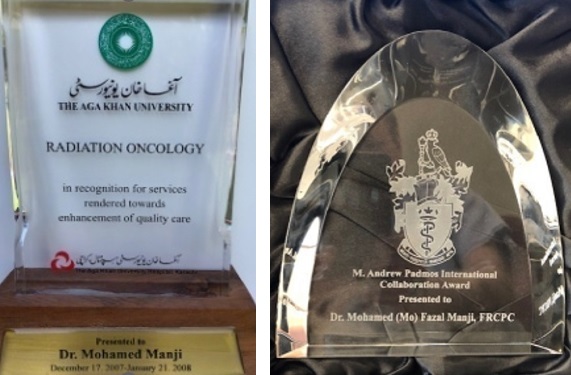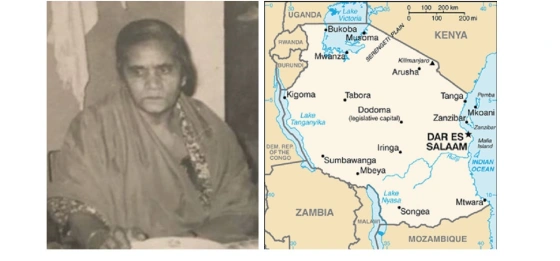By DR. MOHAMED FAZAL MANJI, MD DMRT DABRT FRCPC
PRELUDE: Thirty years ago, Mbeya Town, situated in the Southern Highland region of Tanzania lost Raibanu Sikina Kanji Lalji. She and her husband Rai Kanji Lalji were one of the pioneers of Mbeya. She was a dedicated person not only to her Lalji Bharmal family by marriage but to all communities of the town. Being her grand nephew, I am humbled to write about her so that she is not forgotten and thus will belong to the pages of history of the Indian contribution in the development of East African countries.
It is a misconception that the people of Indian origin in East Africa are descendants of the labourers who built Kenya-Uganda railway. Almost 32,000 workers from Kutch and Punjab were involved in laying a railway line from Mombasa to Kampala. Between 1896 and 1901, 2,493 workers died and 6,454 became invalid while laying the tracks. After the completions, only about 7,000 workers chose to stay back; the rest of them returned to India.
History indicates that there were trade links between Kutch, Gujarat and African coast for centuries. Modern day migration of Indians (or Asians as they were called in East Africa) to East Africa started in early and middle part 19th century. It was estimated that the number of Indians living in Zanzibar in 1859 was around 2,000.
Before, during and after the completion of laying of railway tracks in East African countries, Indian traders, mostly in the beginning from Kutch and then Kathiawar, had migrated to establish trading posts, called “dukas” along the railway routes. There were however others who were brave enough to venture out and establish trading posts in unexplored and dangerous regions of these countries. This was to provide the needs of indigenous populations and also of German and British administrators, living in the towns where they had established administration centers called “Bomas”. One such part was Southern Highland region of German East Africa (Tanganyika) and one such family was of my great grandfather Lalji Bharmal Rana’s children and grandchildren.
Initially, the Indian settlers in East African countries were male Indians. These men came alone without their spouses, as either they felt that the move to East Africa would be temporary and short lived or would send for their wives later on, when financial means permitted. The other group was young single men.
Women, following their migration to East Africa, either to join their husbands or after becoming brides of young single men who had gone back to get married, have played a very major and important role in the success of Indian settlement in Africa in general and East Africa in particular. They not only minded their homes and looked after the children but they were pillars of support for Indian men. They helped their husbands in the “dukas”, looked after the extended family and also helped other women in the community they were living in.
Mbeya and Tukuyu regions of the Southern Highland Province of Tanganyika was blessed with arrival in the early part of 1923 — after her marriage to Wadabapa Kanji Lalji Bharmal — of a lady, who would play a major role not only in the settlement of Lalji Bharmal family and Indian community of various backgrounds and religion but also the betterment of the general population of Mbeya.
Her name was Sikinabai Kanji Lalji — our Wadima, The Grandma of Mbeya.

Wadima Sikina was the daughter of Hirji Rajpar Kalyan from Nagalpur, Kutch. She was a sister of five brothers who all migrated to Tanganyika. The oldest brother, Jaffer, settled in Zanzibar and the rest, Mollo, Merali, Bandali and Suleman settled in Tukuyu. Wadabapa Kanji Lalji was the second son of Lalji Bharmal and being single, immigrated first in early second decade of 20th century. His older brother, Manji, was a family man and a breadwinner for the Lalji Bharmal family, farming on their small piece of land called “Kundhi Wadi”. Thus he was not able to go first to Tanganyika. Wadabapa Kanji Lalji after succeeding in his business, returned to Kutch in 1922 to get married.

The 48th Ismaili Imam, Mawlana Sir Sultan Mahomed Shah, His Highness the Aga Khan lll, had instructed the Kutch Kathiawar Ismaili Jamats to go to East Africa for economical betterment. So this newly married couple was given a big task to take some of Wadabapa’s brothers and nephews with them on their trip back to East Africa to settle them and help them to earn their living there. At a young age of seventeen and as a newly married bride, she took this responsibility with her husband and became the “mother” of the family.
The new home of Wadima, as Mrs Sikinabai Kanji Lalji, will be addressed from now on, was in New-Langenburg (presently known as Tukuyu), a small hillside town in the Southern Highland region of Tanganyika (now known as Tanzania).This was the place the German administration, before 1st World War, had established a center called “Boma”. Mr Kanji Lalji had moved to this place from a close by village of Masoko where he had initially settled in 1911.

In those days, these small villages in East Africa did not have any hotels or restaurants. There were only few Indian families of different backgrounds, i.e. Hindus, Sunni Muslims and Khoja Muslims (mostly Ismailis).They thus had no choice but to look after each other in all ways of life. Any new arrival or visitor would just have to go to any “duka” of an Indian person and he and his family would be taken care of. They would be fed, housed and also would get help so to open their own “dukas” or find them employment, regardless of religious background. This was an old Sindhi, Kutchi and Khatiawadi tradition for generations, practised in India and outside India.
Click on map for enlargement

As very few of the Indian man-folk had wives, Wadimaa played major role in this aspect in Tukuyu, during that time. One such example was an arrival of a Sunni Muslim family of Haji Yusufmia in Tukuyu in late 1920’s or early 1930’s; they had arrived in Tukuyu after crossing Lake Nyassa (Malawi) in a small canoe from Nyasaland. They were on their way to Mbeya region to settle. They stayed with them and Haji Yusufmia made Wadimaa his blood sister. From then on that relationship between these two families continues to exist until the present day and has remained strong among their children and grandchildren. Haji Yusufmia became a prosperous businessman in Mbeya and a respected Muslim community leader in the Southern Highland region. He and his family were officially invited to attend the Diamond Jubilee celebration of Mawlana Sultan Mahomed Shah Aga Khan in 1946 in Dar es Salaam.
Wadima Sikinabai and Wadabapa Kanji Lalji were matriarch of the Lalji Bharmal family in the settlement of Wadabapa’s older brother Manji’s sons and daughters, his younger brothers Hussein and Karim Lalji. They helped them settle, marry and establish themselves in Tanganyika and some of them became quite successful economically.
In spite of being young, Wadima had an inborn mature quality and accepted a major role in the social aspect of the communities. She learned Swahili language and also local tribal language of Nyakyusa. As there were no doctors or official midwives, women helped each other during deliveries. She was one of the main women involved as a “midwife”. She was self-taught by observing and also from a midwifery medical book for women; she told me that she bought this book in Mumbai for 3 rupees during her first return visit to Kutch after her marriage. She also told me (being an MD myself) during our fireplace talks in her later years, while visiting Vancouver, that she still wanted to learn more. She wanted to know about new procedures involved during deliveries in the present modern day.
In 1935, Wadima and her family relocated to Mbeya. They became one of the pioneers of Mbeya. She continued her involvement in Mbeya community in the same way, and in some respect in more involved way. She was the main lady player in establishment of the Ismaili community of Mbeya. She, with her husband served as Mukhiani and Mukhi of Mbeya Ismaili Jamat in 1938. Their names are embedded on the plaque shown below. She also was instrumental in the establishment of other Ismaili majalis gatherings in Mbeya. In early 1950’s, as per Mawlana Sultan Mahomed Shah’s instructions, she was one of the first ladies in Mbeya, to adopt the simple western dress and gave up her Indian attire of “pacheri” and saris. She also was instrumental in getting other reluctant Ismaili ladies to do the same.

Wadima established the Ismaili Ladies Voluntary corps in Mbeya. The following pictures show her involvement over the decades. She also participated in preparing food during Ismaili functions as part of “Jaman” committee. In spite of her age, she also participated in one of the early Vancouver Partnership Walk during her visit to Vancouver, BC.



Over the years, she earned the respect of all communities of Mbeya, whether they were of native African population or of Indian and European background and came to be known as WADIMA (Grandma). She had a persona of being confidant and in expressing authority. Families would get her involved in settlement of family, marital and financial issues of the community. After Tanganyika’s independence on December 9, 1961, local native political leader would come and greet her as she had known them since they were young. At any Indian wedding, she would be consulted and invited. I remember that my father did consult and inform her about weddings in our family.
In the late 1940’s and early 1950’s, members of the Lalji family in Mbeya would visit Wadima’s place once or twice a week after Jamatkhana, for chit-chat. I was very young and my young cousins and young uncles would gather around a “sigree” (charcoal heating utensil), as Mbeya at an altitude of 1,758 metres (5,500 ft) was quite a cold place. The rooms were lit by lanterns; in that period there was no electricity in Mbeya. We would listen to the elders talking about local news, news from Kutch and other family news. Wadima was a very good storyteller. The young ones would sit with her and she would tell to us about our ancestry, about Kutch and their early hard days they went through when she came to Tanganyika and other interesting stories. This was kind of passing on to all of us, our history and informing us, who we were and where we came from.
Her legacy is being remembered and talked about, up to now, by all Lalji Bharmal youngsters, who were sitting around the “sigree” in those early days and also the new Lalji Bharmal generations in the latter days. When we get together here in Canada and talk about Mbeya, we remember her by saying to each other that “Wadima was saying so”.
Wadima during one of her visit to Vancouver in early 1990’s fell sick. Her wish always was to be buried in the African soil. She returned to Mbeya, Tanzania, her “home”. She passed away in Mbeya, surrounded by family, at the age of 88 years, on February 8th, 1994, and she is buried in Mbeya, Tanzania — the place she was a part of in building.
As I reflect on her magnificent life, I pray for the peace of her soul as well as the souls of all the departed members of my family.
Acknowledgements: I would like to first acknowledge my late Wadima Raibanu Sikina Kanji Lalji herself. She over the years provided me her history, which enabled me to pen down the above write up. I would also like to acknowledge my father’s first cousin and Wadimaa’s son Mr Badrudin Kanji Lalji, his daughter Al-Shamsh (Shamshi) Ladha and Wadimaa’s blood bother’s son Haji Satarmia Haji Yusufmia for providing information for this write up.
Date posted: March 16, 2023.
Last updated: March 18, 2023 (names, typo corrections.)
_______________

Dr Mohamed Fazal Manji, a cancer special and recipient of the 2022 Royal College of Canada M. Andrew Padmos International Collaboration Award, is originally from Mbeya, Tanzania. He is a Consultant Radiation Oncologist at BC Cancer Agency of British Columbia, Canada, and Clinical Associate Professor, University of British Columbia.He graduated in medicine from Makerere University, Kampala, Uganda and immigrated to Canada in 1972. Dr. Manji specialised in radiation cancer treatments at Princess Margaret Hospital (Cancer Center as it is called now) in Toronto. He obtained the Canadian Fellowship (FRCPC) and American Board Specialist Certification (DABRT) in Radiation Oncology. He also undertook special courses in Nuclear Medicine and Endocrinology at Harvard Medical School, Boston USA. He became the first Canadian trained Ismaili Radiation Oncologist in Canada and probably in North America.

He has been working at BC Cancer agency since 1977. He spent time abroad, working in Riyadh, Saudi Arabia, to help modernize the Radiation Department at King Faisal Specialist Hospital & Research Center. He spent 12 years at this tertiary hospital for cancer and other diseases. He was also involved in the planning and development of Radiation Oncology Departments at the Aga Khan University Hospitals in Karachi and Nairobi and spent some time working at both places. He has contributed to many peer review publications, abstracts, book chapters and also lecture presentations nationally and internationally. He is the son of Rai Fazal Manji of Mbeya Tanzania, who served as a member of Aga Khan Supreme Council of Tanganyika in 1950’s and Raibanu Rehmat Fazal Manji, daughter of Alijah Mohamed Hamir who, in early 1930’s, built an iconic Jamatkhana in Iringa, Tanzania, and donated it to Imam Sultan Mahomed Shah unconditionally. Dr Manji served as first Member for Health on the first Aga Khan Ismaili Regional Council of Ontario and Quebec in 1973. He has previously contributed an informative piece on Prince Amyn Aga Khan’s visit to Toronto in 1973 on Simerg’s sister website Barakah.
_____________
Before departing this website, please take a moment to review Simerg’s Table of Contents for links to hundreds of thought-provoking pieces on a vast array of subjects including faith and culture, history and philosophy, and arts and letters to name a few. Also visit Simerg’s sister websites Barakah, dedicated to His Highness the Aga Khan, and Simergphotos. The editor may be reached via email at mmerchant@simerg.com.

